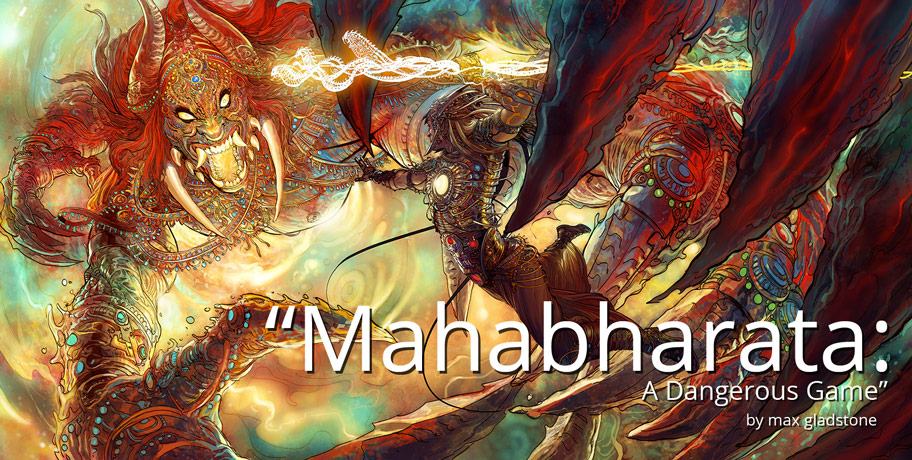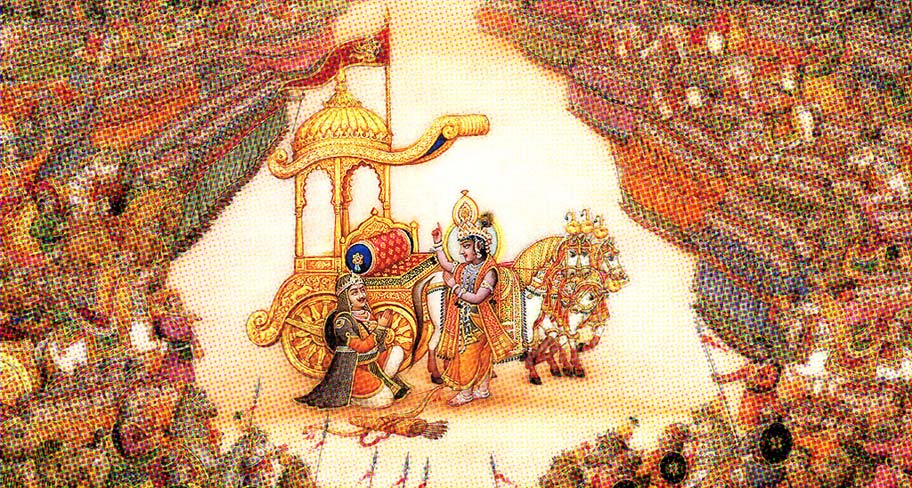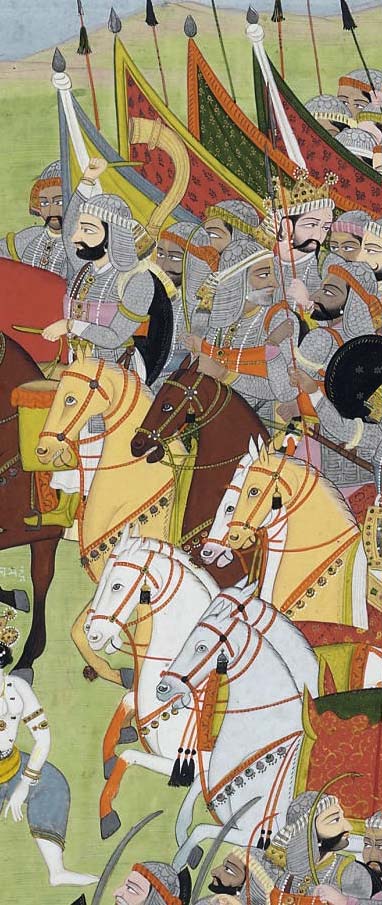
Art by Nisachar
Mahabharata: A Dangerous Game
My enthusiasm and love for these characters and this story will serve for the purpose at hand: encouraging you, dear reader, to immerse yourself in the Mahabharata.
The last two iterations of this column have played it safe. I’ve read Journey to the West in two languages and studied it from a variety of angles, and Romance of the Three Kingdoms, too though to a lesser extent. I could continue in this vein—the next logical essay would be on Outlaws of the Marsh / The Water Margin, China’s great Robin Hood novel and one of Mao Zedong’s favorite books, followed probably by Dream of the Red Chamber for more domestic source material. (Or Jin Ping Mei, if we want to get the sexy-fun-times element in play…)
But while all these stories are great, I’m not as passionate about them as I am about the story I want to discuss now. The problem is, I’m nowhere near as cut out to write this essay as I was the first two—I don’t know the source language, Sanskrit, and I haven’t spent as much time studying the work’s cultural context. (I’m not ignorant, I just don’t have a four year degree, six years of language study, and three years in-country.) There’s also much more chance I’ll do inadvertent harm writing this essay, since the text I’m about to discuss is a live, and lived, religious document in addition to one of the greatest adventure stories, romances, war stories, and apocalyptic tales of all time.
That said, maybe my enthusiasm and love for these characters and this story will serve for the purpose at hand: encouraging you, dear reader, to immerse yourself in the Mahabharata. And I hope that will be worth whatever unintentional harm I do.
The Great Tale of the Bharata Dynasty
Here’s the story, in its most basic form: a kingdom rises, model to the world, marvel of civilization. Two princes stand in line for the throne. The elder, Dhritarashtra, is blind and cannot be king; the younger, Pandu, rules, until, on a hunt one day he kills two deer making love. The dying deer (who are actually a transformed sage and his wife) curse him—the next time he lies with a woman, he too will die. We can’t have a king who can’t sire heirs, so Pandu abdicates, leaving the throne to his brother.
The cursed prince and his two wives still want children, though—fortunately the elder wife knows a magical mantra that will summon gods to give her children. She teaches it to the younger wife, and soon five demigods are born, Yudhithira the just, Bhima the strong, Arjuna greatest of archers, and the beautiful twins Nakula and Sahadeva. They grow well and strong, but in the end Pandu gives in to desire, sleeps with his younger wife, and dies; the young woman then commits suicide from sorrow.

The Pandavas, children of gods, excel; they go on great adventures, gather allies and fortunes, win the hand of the fairest maiden in the world. Meanwhile the Kaurava burn with jealousy.
Pandu’s elder wife, Kunti, and their five sons (called Pandavas after their father) return to the palace, only to find that Dhritarashtra, their uncle, has sired a hundred sons (the Kaurava) in their absence. The Pandavas and Kaurava are raised together, trained by the same masters in the arts of warfare, magic, and politics. The Pandavas, children of gods, excel; they go on great adventures, gather allies and fortunes, win the hand of the fairest maiden in the world. Meanwhile the Kaurava burn with jealousy.
At last, Duryodhana, eldest of the Kaurava princes, plays dice with Yudhisthara, and cheats (sort of), winning from him his kingdom, his wife, and the freedom of his brothers. Through the intervention of gods, and the blind king, and the Pandavas’ wife Draupadi, the brothers are freed, but exiled from the kingdom for years. Together, the Pandava, Draupadi, and their mother set off into the wilderness.
But their exile is not a period of rest and contemplation. They gather weapons, and allies, to retake their kingdom. They seek secret magic from the gods. They bind demons, and infiltrate rival nations in disguise. And when their exile expires, they meet their cousins, an army at their backs, for a battle that may well destroy the world—a battle in which they will be pitted against relatives and teachers, a battle in which the very notion of what it means to be a warrior and a king will be called into question, and that question answered in the most epic way imaginable.
The Mahabharata is a tale of tales. It is the story of an entire age of the world. Gods fight heroes in the sky and on land, and use weapons that can break the universe in half. One episode from late in the war features a young man who wants to take vengeance for his father’s murder by using what I can only describe as a magical thermonuclear warhead to destroy the planet. Timescales are measured in trillions of years; armies are composed of millions, and some of the people we meet on the field of truth and the battlefield of life are basically human Death Stars. And for all this grandiosity, the Mahabharata also features small and human moments of loyalty, justice, sorrow and joy and failure, comedy and tragedy.
When it comes to epic fantasy, the Mahabharata has all that and a talking monkey. (Though the monkey only guest stars in this story.)
How Great are we Talking About Here Exactly?
The Mahabharata is long. Seriously long. Ten times longer than the Illiad and the Odyssey put together. Two and a half times as long as the Bible. But if you’re reading this, I assume you’re a fantasy fan, so you have no reason to shrink from length. After all, we’re only talking about a single book a little less than half the length of the entire Wheel of Time series.
That said, the Mahabharata contains a lot of stuff. As the text itself says:
What is found herein may also be found in other sources,
What is not found herein does not matter.
 So in addition to the adventure story you’ll find philosophy, economics, treatises on warfare, religion, mysticism, politics, proper gambling—as discursive and in depth a text as you’ll find just about anywhere. Fans of Neal Stephenson will find themselves right at home. People who want a little more story and less digression, though, may be well served steering clear of the complete text until they have a basic grasp of the story and structure, which you can get from abridged versions and retellings.
So in addition to the adventure story you’ll find philosophy, economics, treatises on warfare, religion, mysticism, politics, proper gambling—as discursive and in depth a text as you’ll find just about anywhere. Fans of Neal Stephenson will find themselves right at home. People who want a little more story and less digression, though, may be well served steering clear of the complete text until they have a basic grasp of the story and structure, which you can get from abridged versions and retellings.
Part of the reason I say this is that complete, high-quality translations of the full text of the Mahabharata into English are hard even to conceive given the poem’s length. One of the complete translations, by Kisari Mohan Ganguli, is over a century old, but remains well-regarded — and in the public domain! Ganguli’s translation is not based on the most recent critical edition of the Sanskrit, but that shouldn’t be a big problem for someone who’s interested in the text primarily as a told story. There’s also a complete translation underway by the University of Chicago—picking up where the previous translator, J.A.B. van Buitenen, left off when he passed on. Perhaps someone with a little more scholarly expertise in the area than I have will help us with their opinions in the comments—I really can’t speak to the quality of either translation as a rendering of the original. Economist / translator / literary scholar Bibek Debroy is also working on a full translation, published in the US by Penguin.
As for the abridged versions, I have a very soft spot in my heart for William Buck’s one volume retelling of the core story, in part because that was my first exposure to the Mahabharata. Buck’s recast the epic poem into prose, but I find his work lyrical and compelling. Given the sheer mass of the Mahabharata, this is a good place for folks uncomfortable with the thought of diving into 1.8 million words of poetry to start!
The Story in Other Forms
My knowledge of the shapes the Mahabharata has taken in Indian pop culture is limited, since I haven’t spent time in India. But if you’re interested in exploring the story through its adaptations and re-imaginings, I do have a couple places for you to start! And with luck, people more expert than I will be able to round out my recommendations.
Movies / TV
The arch-television adaptation of the Mahabharata is probably the 1988 Mahabharat, a wildly successful high-budget 94 episode series that adapts the core plot through the end of the war. Episodes are easy to find on Youtube. A couple recent Indian television series have attempted to adapt the story, though Wikipedia suggests that they’ve seen more limited success & run into financial difficulties.
Also worth a mention is Peter Brook’s gigantic (9 hour!) stage play Mahabharata, which was then converted into a 6 hour or so long TV miniseries. I really enjoyed the miniseries, which is very much a film adaptation of a stage play—expect more emphasis on dramatic situations and dialogue than on the kind of full-out fight scenes with Matrix-meets-Pacific Rim style action that really should be part of a Mahabharata adaptation. But the story’s told, well, with feeling. Again, the kind of show to which you dedicate a Saturday, though this’ll be a more cerebral Saturday than Red Cliff. WARNING: If you get this (eBay’s a good place), please pay close attention to the edition you’re receiving. There’s a further edit of the 6-hour miniseries into a 3-hour film, and the three hour version loses a lot of acting and story.
Comics!
The over-the-top battle scenes and sheer scope of the Mahabharata make it exceptionally well-suited to comic book adaptation. Unfortunately, as I search around Amazon it looks like a lot of the comic versions are expensive in the USA. Amar Chitra Katha’s 42-issue comic book version is the ur-comic Mahabharata, but I haven’t read it. I have read, and fallen in love with, Amruta Patil’s Adi Parva, a painterly graphic novel that adapts the epic’s first book. Beautiful, expansive, sensitive and spiritual—a friend brought it back for me from a trip to India and I leaf through it whenever I want to read something stunning. I can only hope that Patil’s working on the next volume now.
Games!
Sadly, I haven’t been able to find a Mahabharata video game. There are hints of one floating around out in the ether, but I haven’t seen any finished copies. Not all stories are equally graced with awesome video game adaptations, sadly. But, if any of you out there are developers, know that there’s no more epic subject matter than the Mahabharata‘s final battle, and if you successfully translate it into interactive form I at least will windmill-buy that game.
Conclusion
The Mahabharata is nine or ten of the great everythings of all time: love stories, war stories, philosophical tracts, tales of chivalry, superhero tales, stories of betrayal, tragedies, comedies. Any fantasy fan will find what they’re looking for here—and something more besides. Read it. Know it.
And once you’re done, the Ramayana’s length will seem almost manageable by comparison!


“the 1988 Mahabharat, a wildly successful high-budget 94 episode series”
The special effects are very much 1978, though … :D
Still, definitely a good way to get a glimpse into the story, especially the Bhagavad Gita, which forms the heart of the Mahabharata.
There are quite a few modern retelling of this epic.
You could check out Ramesh Menon – Mahabharatha
There is another retelling in English which has been started recently by Ashok Banker called the MBA series.
There are many other earlier retellings – some done from point of view different characters in Mahabharatha – like there is one translated from Malayalam told from the perspective of Bhima and so on.
@Brian – Yes! The Gita section is so hard to dramatize, but such an important element of the story. (Maybe I should have mentioned The Legend of Bagger Vance in the film adaptations section? I think the original novel was supposed to be an adaptation of / commentary on the Gita, with Vance as Krishna.)
@Sathish—Thank you for the recommendation! Always on the lookout for more retellings. I’ll check out the ones you mention. One of the many reasons the Mahabharata is so great is the sheer drama of the material, which makes approaches like those character-perspective retellings possible & cool.
[…] on Aidan Moher’s blog, I rant for a while on why the Mahabharata is one of the coolest stories ever and why everyone, but most especially fantasy fans, should read it. Previous posts in this vein […]
It feels really good to see Indian stories getting praised here. Do check out the Ashok Banker series on the Ramayana (completed) and the Mahabharata(ongoing). Although, i must admit i haven’t read them, but friends seem to swear by the books.
The Palace of Illusions by Chitra Banerjee Divakaruni is another approach at retelling the epic from Draupadi’s point of view.
Our epics are really epic in scale!
Peter Brook’s TV miniseries left a very deep impression on me when I was a teenager. It helped me shape so many of my views and thinking. So good to see someone recognizing the incredible dramatic potential of Mahabharata. It’s a wonderful and deeply moving masterpiece.
Have you tried KM Munshi’s Krishnavatara? Brilliant stuff!
Wow, thanks for the interesting article. I actually even don’t know about Mahabharata games :)
Great article, by far and away the best Mahabharata version I have read is the Krishna Dharma version, very true to the original sanskrit but rewritten in a very gripping rich narrative style. You can listen to a free audio-book version of it here: http://sevaashram.com/sermons/sri-mahabharata-audio-book-sarvabhavana/
I too am waiting for a video game! What happend to the game by Syncere Arts? It was talked about in 2007 all over the place and since then nothing… I fear the company went under?
http://www.gameguru.in/features/2007/05/mahabharata-the-dawn-of-kaliyuga-by-syncere-arts-exclusive-interview/
http://nisachar.deviantart.com/
http://nisachar.deviantart.com/art/MBX-Vol-03-18-Bheem-challenges-312933313
Would love to see a top class Hollywood movie featuring Bheem based on Nisachar’s artwork. I think Marvel can do a great job
Nisachar’s artwork
http://nisachar.deviantart.com/art/MBX-XTRA-Karna-Vs-Ghatotkach-Winner-Loses-all-312933960
The story of Mahabharata is excellent in “Parva” by S L Bhyrappa. English translation is available.
This is one of the best work of art ever created in India.
The simplest book in the story form is ‘Mahabharata Katha’ (The story of Mahabharata) by C. Rajgopalacharya (Independent India’s first Governor). It is translated in English by P. Somasundaram. Syncre Studios is making a pc game ‘Mahabharata : Dawn of Kaliyaga’ from last 5 years. But still incomplete. Hope it will be completed soon.
[…] – http://fantasybookcritic.blogspot.com/2013/05/the-mahabharata-recollection-and-q-with.html – http://aidanmoher.com/blog/2013/04/articles/broader-fantasy-foundations-part-three-mahabharata-by-ma… […]